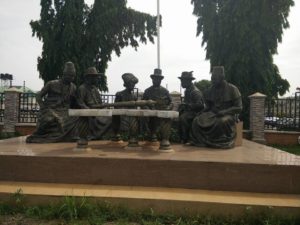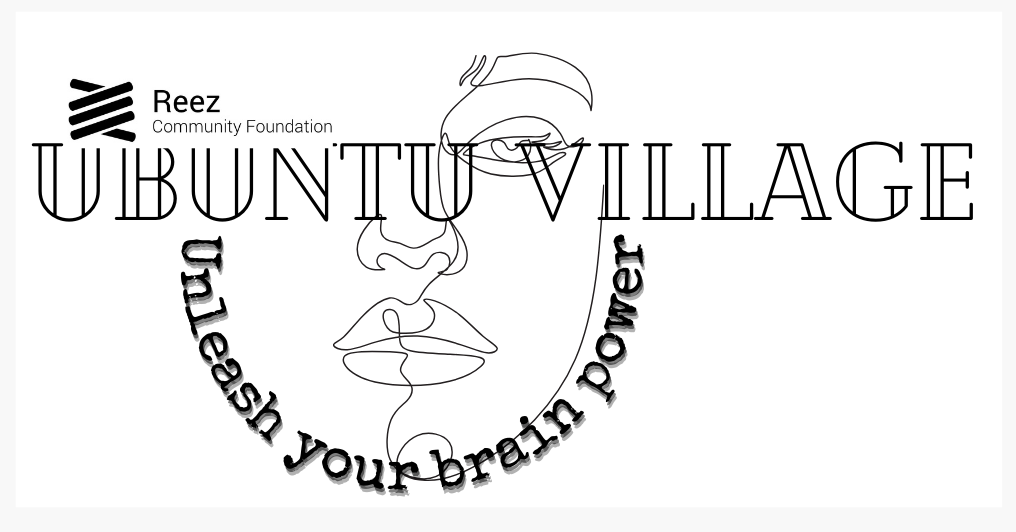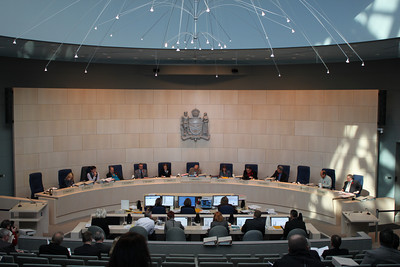A City’s Journey on Addressing and Eliminating Racism – Time to Exit the Ring Road.
Background
Racism has always being part of the human condition. Therefore, it is fair to say that the approach and actions by the municipal government of Edmonton to tackle this issue overtime is all over the map. Recent evidence show that the City Council and administration have had multiple attempts to move away from the 1930s when they were approving KKK cross burning events to trying to address and eliminate racism. In this state of trying, we have had initiatives galore individually and in conjunction with to a number of community organizations with much work yet to be done.

2. The City of Edmonton, like all public organizations, has a constitutional and statutory obligation to ensure equality for specific groups of people. Under section 15 of the Canadian Charter of Rights and Freedom race is one of the enumerated characteristics. Race is also one of the fourteen grounds under Alberta Human Rights provisions. In upholding these constitutional and statutory obligations, maintaining community harmony is an ongoing challenge for municipalities. Perhaps, due to the implicit requirement to addressing and eliminating racism whist maintaining public harmony or good relations or community spirit. How well the City has managed this dancing exercise is undoubtedly an ongoing challenge.
I
A Renewal
- The launched of #Makeitawkward campaign on September 2nd felt like yet another initiative was underway with Jesse Lipscombe and the wider community. Indeed, concerns about racism experienced by some in our midst have been swirling for years. Stories are abound, culminating in a summer of public display of racism towards Bashir Ahmed and Jesse Lipscombe. We have all heard stories of those who lose their job, are harassed, taunted or are carded due to the “skin that they are in” – to borrow from Desmond Cole of Toronto Star.
- However, confluence of events including the campaign generated enhanced excitement in the community that led to diverse “awkward” conversations. One of these community conversations led to Black representatives from Racism Free Edmonton ad hoc coalition to meet with Mayor Iverson on November 3rd. They spoke with one voice, following which the Don Iveson, responded with an open email dated November 4th, indicating his intention to pass a Council motion. He noted:
“Our governance structure sets out that administration requires a formal direction from Council in order to act on an initiative of this scope. Formalized council support through a motion, also ensures that the work can proceed effectively and with accountability back to elected leaders”. He continued “…
- The journey began and the motion was passed on November 8. The Council’s motion was introduced by Moe Banger and seconded by the Mayor. The Mayor immediately announced it on Facebook. The post was later boosted, in part to honour his desire to “involve all the necessary voices and perspectives – including the ones that were not present” at the meeting.
- Indeed, they spoke, although the value of this aspect of the conversation is not yet clear to me. As at November 13th, the post had attracted 90 comments, 1.6k emoji reactions and 260 shares. The emojis mirrors the comments, ranging from likes, love to flaming faces. The comments themselves
 were illuminating. Some of them suggests misunderstandings or ignorance of the nature of racism specifically and discrimination generally. It is a shame that the medium of Facebook does not afford an opportunity to adequately address concerns or contextually educate those who require it. After all, that ought to be an important aspect of promoting good relations.
were illuminating. Some of them suggests misunderstandings or ignorance of the nature of racism specifically and discrimination generally. It is a shame that the medium of Facebook does not afford an opportunity to adequately address concerns or contextually educate those who require it. After all, that ought to be an important aspect of promoting good relations.
II
- According to the Mayor’s November 4th email, “the wording of the motion is expected to be deliberately high level to give broad based direction as well as flexibility. It is driven by the spirit of collaboration and [his] expectation is that the scope and terms of the work will be discussed openly with the [community] before it even begins. The motion is only the beginning of the journey…” It was high level, subsuming the detailed individual complaints.
- Naturally, individual concerns are numerous, representing detailed symptoms of systemic inefficiencies, against a backdrop of an electorate and staff members who may not appreciate or understand the human rights and equality implications. To effectively address and eliminate racism it makes sense for the motion to be sufficiently high level. However, we take the position that the motion in its current form is not sufficiently high level to engender sustainable and systemic efforts overtime. For this to happen, its focus ought to be on the City Auditor not Administration.
- To adequately address issues raised by this position, it is helpful to reproduce the motion as posted on Facebook. Thus:
- “That Administration prepare and bring forward to a City Council meeting, a framework to guide, facilitate and coordinate efforts to support inclusion and eliminate racism in Edmonton. The framework should incorporate:
- In what ways the City of Edmonton currently supports, and in the future could support, grassroots and citizen-led anti-racism initiatives;
- The actions and results of the work being done within the City, its Boards and Commissions, to support broader inclusion and community participation; and
- Recommendations for how the City, and its Boards and Commissions, should work to eliminate systemic racism and discrimination through its policies and strategy implementation; and
- Information on how the City currently supports staff who experience discrimination and recommendations to enhance safe disclosure.
- This framework should be built on a broad and comprehensive consultation with all relevant stakeholders to define the City’s and community’s roles for this work going forward.
- “That Administration prepare and bring forward to a City Council meeting, a framework to guide, facilitate and coordinate efforts to support inclusion and eliminate racism in Edmonton. The framework should incorporate:
- Our intention is to direct administration to prepare a framework for how the city can work to end racism, and support community groups doing the same.”
II
Analysis
- The noted intention of the motion is to direct administration to prepare a framework. However, the City already has a framework. Why? The City approved its Diversity and Inclusion policy (C538) in October 17, 2008. This led to City Procedure known as the Diversity and Inclusion Framework (C538) approval on March 19, 2009. The procedure notes in the Executive Summary stated that “the Diversity and Inclusion Framework reflects Senior Management Team’s (SMT) vision of creating an innovative organization that works smart, a City workforce that attracts and leverages diversity in its staff to create programs and services that meet the diverse needs of the changing communities we serve”. It continues, that SMT’s four goals were:
- Having a workforce that is broadly reflective of the community;
- Identifying and addressing barriers within organizational systems;
- Attracting and retaining a talented workforce skilled at working in an inclusive and respectful manner with one another and with the community; and
- Creating process, policies, plans, practices, programs and services that meet the diverse needs of those we serve”
- All these clearly describes desirable outcomes for any human rights and equality advocate including those focusing on race discrimination. So the issue is whether this motion sustainably moves the City along its path to effectively address and eliminate racism. In doing so, our preferred usage will be “human rights and equality”. This phrase is also preferred in relations City conversations about gender based analysis plus.
- The motion is clearly rendered ineffective by the failure to acknowledge the existence of framework, thus suggesting a lack of awareness that a framework already exist. This then raises two secondary issues. Firstly, it appears the motion just got them onto a circular road on their journey to effectively address racism. The motion is not time bound, so Administration can just keep working on the issues identified with limited attention to addressing persistent daily inequality issues. The second issue raised by the motion is rhetoric question of why would Council be unaware that the City has been implementing a Diversity and Inclusion Framework since 2009? One can only speculate, nonetheless, its existence was not systematically monitored or picked up in any of the Council’s oversight mechanisms including through the activities of the Office of the City Auditor. There is a great need for Councillor’s training to equip them to be alive to these issues in their roles. Consequently, the motion ought to use these aspects as a means to generate the information sought whilst cultivating the desired change.
III
The role of the City Auditor is distinct from that of the City Manager and Administration. The City Aud itor is directly accountable to the Council not the City Manager as provided for under Bylaw 12424. The accountability mechanism of the City Manager and the rest of City administration are provided for under Bylaw 12005.
itor is directly accountable to the Council not the City Manager as provided for under Bylaw 12424. The accountability mechanism of the City Manager and the rest of City administration are provided for under Bylaw 12005.
Bylaw 12424 Review
- The City Auditor is responsible for all internal auditing activities within City Programs and City Agencies including:
- Independent, objective assurance and consulting activities designed to add value and improve City’s Programs.
- Assisting the City to accomplish its objectives by bringing a systematic, disciplined approach to evaluate and improve the effectiveness of risk management, control and governance processes.
- Coordination of fraud investigation activities within City Programs or City Agencies.
- Submits concurrently with the City Manager, a budget for the next calendar year;
- Submit at least four times per year a summarized status of projects and its own budget performance etc[1]
- The Bylaw provides a useful definition of program. Program means an activity:
- Designed to improve social, economic or environmental conditions in a society;
- Related to the delivery of City services; or
- Internal to the City administration to improve employee relations; and
- Special projects, which are those listed in the annual work plan. Annual work plan are those approved annually by Council which lists audits, investigations, studies, follow-up and other projects to be performed by the City Auditor.
- In carrying out this work, the Auditor has two roles[2] to act as an agent of change and a guardian. As an agent of change, the Auditor is expected to be proactive and forward looking in its choice of projects. These projects are expected to focus on provision of strategic, risk and control related consulting services to better serve the changing needs of the corporation and help bring about improvement in program performance. As a guardian projects are expected to be primarily focused on assurance by evaluating for compliance, efficiency, effectiveness, economy and controls. The work of the City Auditor is supported by the Audit Committee established under Bylaw 16097.
- The matters delegated to the Audit Committee are to act as a standing committee of Council and:
- Assist Council to fulfill its oversight responsibilities by reviewing reports from the Administration, External Auditor and City Auditor. The City Auditor’s reports includes those relating to issues in respect to its mandate as established under the City Auditor’s Bylaw – sections 4, 15 and 15(e).
- On reviewing reports, the Committee may receive it for information; send it to Council with or without recommendations; request additional information before sending it to Council or make decisions on the matter –s7.
- The Committee has the power to approve the City Auditor’s annual work plan and any changes requested by the Auditor if within approved budgets (s10)
- Assist Council to fulfill its oversight responsibilities by reviewing reports from the Administration, External Auditor and City Auditor. The City Auditor’s reports includes those relating to issues in respect to its mandate as established under the City Auditor’s Bylaw – sections 4, 15 and 15(e).
17. Given the constitutional, statutory and moral nature of the City’s human rights and equality responsibilities, the question that the motion ought to address is: to what extent did the Program Area audits captured human rights and equality impact issues? To address this question the Office of the City Auditor and the Audit Committee would need to clarify the following:
- Did the Program Area Risk Self-Assessment tool used by all program areas in 2014 capture these issues?
- Is the City-Wide program areas risk assessments planned for 2017 going to address these issues? If not, how soon can this be corrected?
- How would these be reflected in the 2017 Work plan?
- When should Council expect a report?
18. With ongoing repeated complaints by communities of colour, it is inarguable that the City Auditor has not sufficiently exercised its agent of change and guardianship roles in this regard. The City of Edmonton’s reputation risks are real, yet the “systematic, disciplined approach to evaluate and improve the effectiveness of risk management, control and governance processes”[3] of program areas performance in relation to human rights and equality, appear to be lacking. Perhaps these will be in the internal audit reports that are not publicly available, if not, the inefficiencies in the Auditing processes needs to be addressed.
disciplined approach to evaluate and improve the effectiveness of risk management, control and governance processes”[3] of program areas performance in relation to human rights and equality, appear to be lacking. Perhaps these will be in the internal audit reports that are not publicly available, if not, the inefficiencies in the Auditing processes needs to be addressed.
IV
Engaging with Intent to Address and Eliminate Racism
- In the spirit of collaboration, it is important for the City to recognize that being able to identify and address human rights and equality impact as a core competence of every City staff whose role directly or indirectly impact other people. This means the reach of the constitutional, statutory and Bylaw provisions goes beyond the human resources function to almost all corporate functions including audits. Consequently, a Centre of Excellence might be a good idea to coordinate and offer training as well as share best practice. Indeed, there is a giant size capacity challenge that can only be addressed systematically through audits and on the job training. In any case, there is a great need for specific context training to facilitate the promoting of good relations aspect of effectively addressing racism or discrimination generally. This is more likely to reduce negative reactions or misunderstanding due to the real possibility that employees will find it easier to make as linkages, their respective job tasks. Consequently, in engaging with the community, the City needs to acknowledge that Community-led resolution does not absolve the need for the City to get its house in order.
- It is time for the City of Edmonton to exit the ring road aspect of its journey to effectively address and eliminate racial discrimination. This is an issue that the organization is confronting in multiple fronts and already recognized its systemic nature. The existing Diversity and Inclusion Framework says so, so does the is End Poverty Strategy and road map.
- To effectively exit the ring road onto the highway to addressing and eliminating racism, Council need to do the following:
- Withdraw or markedly amend the November 8 motion.
- Reintroduce or amend the motion to specifically direct the City Auditor.
- The amended or new motion to include a recognition that each element of existing motion will be captured in the relevant Program Area Risk Self-Assessment and highlighted in the City Auditor’s reports.
- Authorize the City Auditor and Audit Committee to have the necessary human rights and equality mainstreaming capability, in the short, medium and long term.
- Additionally, the motion should also address the following:
- That the City Auditor confirms whether or not the Program Area Risk Self-Assessment tool used by all program areas in 2014 captured assessment of human rights and equality impact of policies, procedures and overall program delivery.
- If it did, would it be retained and improved upon in the tool that will be used for a similar program areas risk assessments planned for 2017?
- If it did not, how soon would the 2017 tool be corrected?
- That human rights and equality impact assessments by program areas be reflected in the 2017 Work plan.
- That a report to Council is expected from the Audit Committee and City Auditor on this motion on a specified date no later than the next 60 days, hence.
- That the City Auditor confirms whether or not the Program Area Risk Self-Assessment tool used by all program areas in 2014 captured assessment of human rights and equality impact of policies, procedures and overall program delivery.
- This is what engaging with real intent looks like.
V
- For those who argue that human rights and equality do not impact Audits and that their focus ought to be just the monies, it is worth directing their attention to the lack of such exceptions to the constitutional and statutory obligations of the City. The summary of Bylaw 12424 in paragraphs 12-15 above may also suffice. Therefore, since no function is excluded, it is logical to expect that, like any other function that directly or indirectly impact people, the human rights and equality impact of their policies ought to be evaluated. That is what a “proactive and forward looking” [4] City Auditor ought to do as part of their change agent role.
- Human rights and equality Impact assessment requires organizations to consider all disaggregated relevant, available information in order to anticipate any likely negative impact on people from the perspective of their enumerated characteristics such as different racial groups and disabled people. Once identified, one then seeks to avoid that negative impact by taking alternativ
 e courses of action wherever possible. Should a public organization find that they are unable to avoid any potential negative impact which arises as a result of the decision, this must be a key consideration of future action(s). It is best practice to put in place robust ongoing monitoring infrastructure that area disaggregated. This will help with program evaluation and also capture unintended impact: just what the City Auditor does.
e courses of action wherever possible. Should a public organization find that they are unable to avoid any potential negative impact which arises as a result of the decision, this must be a key consideration of future action(s). It is best practice to put in place robust ongoing monitoring infrastructure that area disaggregated. This will help with program evaluation and also capture unintended impact: just what the City Auditor does. - It is important to bear in mind that information is not limited to research data from Statistics Canada or any other research data, it extends to feedback from communities potentially impacted by the policies, procedures or programs or services that may be under consideration.
- A systemic problem demands a systemic response. Time to rein in the initiatives galore and aim for effective synergy.
In Solidarity!
Ufuoma
——————————————————————————————————————–
 Ufuoma (who-fo-ma) Odebala-Fregene is the co-founder and Executive Director of Reez Business Solutions Inc. (www.reezimmigration.com). She is an experienced legal professional with extensive background in Canadian immigration law, policy and practice; entrepreneurship and human rights compliance.
Ufuoma (who-fo-ma) Odebala-Fregene is the co-founder and Executive Director of Reez Business Solutions Inc. (www.reezimmigration.com). She is an experienced legal professional with extensive background in Canadian immigration law, policy and practice; entrepreneurship and human rights compliance.
In addition to her work with individual clients, Ufuoma is the host, researcher and publisher of the immigrant compass podcast (www.theimmigrantcompass.com). In the past she worked with Race Equality Commission of England & Wales and its replacement organization, the Equality and Human Rights Commission of England and Wales. In this role she engaged extensively with UK’s local government and health organizations on their change management and organisational development efforts through the use of equality and human rights impact assessment tools.
Ufuoma is a founding member of Savanna Skills Corporation now trading as Reez Community Foundation. Reez is an organization dedicated to alleviating poverty by fostering just and economic resilient communities by building capacity to attain career self-reliance through focused actions on employment, education, volunteering and ultimately self-employment with particular emphasis on worker-owned businesses (www.reezcommunity.org). She is also a Steering Committee member of the Edmonton Financial Empowerment Collaborative, an Executive member of BLM Yeg & Area and a member of the Church of Jesus Christ and Latter Day Saints. The common message in all her efforts is to make progressively tangible positive improvements towards resilience in the lives of those around her, her communities and herself. She can be reached on twitter @ufuomaof or by email: fregene@shaw.ca. For a consolidated glimpse of Ufuoma’s ongoing projects, please visit www.ufuomaofregene.com
[1] Section 10, Bylaw 12424
[2] Section 9, Bylaw 12424
[3] Section 10(1)(b) of Bylaw 12424
[4] Section 9, Bylaw 12424

